When will gold break through $1,000 an ounce?
Precious metals come in two flavours: monetary and industrial. Gold is primarily monetary; the others, industrial. There is no call for industrial metals now, but, says Dominic Frisby, gold will take off soon - and you should be ready.
Today, I want to look at precious metals in general. Not just gold, but silver, platinum, palladium and even some of the lesser-known platinum-group metals, such as rhodium and indium.
We are living through one of the greatest financial crises in history - possibly the greatest. The contraction in credit has forced selling in everything.
Many were under the illusion that precious metals would be safe in such a scenario. But they haven't been. Let's look at why.
MoneyWeek
Subscribe to MoneyWeek today and get your first six magazine issues absolutely FREE

Sign up to Money Morning
Don't miss the latest investment and personal finances news, market analysis, plus money-saving tips with our free twice-daily newsletter
Don't miss the latest investment and personal finances news, market analysis, plus money-saving tips with our free twice-daily newsletter
Gold is maintaining its purchasing power, unlike money
The key thing to remember is that this is a financial crisis - a crisis of money. Of all the precious metals, gold is the only purely monetary metal. Yes, it has some industrial use - but a negligible amount. Gold's use in jewellery has derived from its monetary function, which is to store wealth.
Money has two functions: one is to be a medium of exchange, the other to store wealth. Gold has long since been useless as the former (although, technically, sovereigns are still legal tender) but as the latter it has acted soundly. Yes, it fell against the yen last year, but so did everything. Yes, it was volatile against the dollar, but in the grand scheme of things, gold is maintaining its purchasing power, while money - be it the yen, the dollar or the euro - is falling.
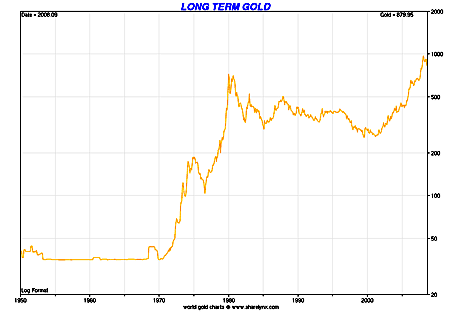
Some currencies have been weaker than the dollar. One ounce of gold now costs 110,000 Icelandic krona, for example, up from around 40,000 in 2007. To be honest, I'm surprised it isn't higher. (Thanks to Nick Laird at www.sharelynx.com for the charts)
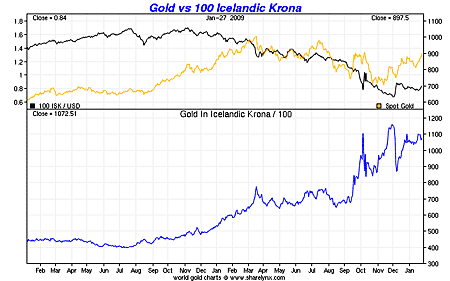
Britain has similar, though currently less extreme, problems to Iceland. This has been reflected in the price of the pound against gold.
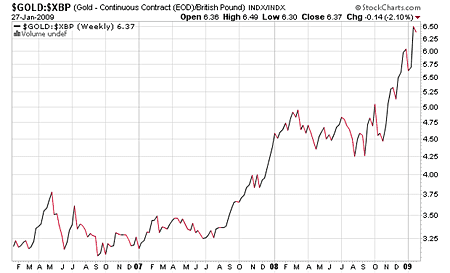
So gold, although volatile, has performed well.
Silver is more vulnerable than gold
Silver, too, is a monetary metal. As many of you will know, the words 'silver' and 'money' are interchangeable in some ninety or more languages: 'argent' in French, for example; 'plata' in Spanish; 'pound sterling' once meant a pound of sterling silver. But, historically, silver's role as money was less as a store of wealth and more as a day-to-day medium of exchange. That role has now expired.
Enjoying this article? Sign up for our free daily email, Money Morning, to receive intelligent investment advice every weekday. Sign up to Money Morning.
Many silver bugs will point to silver's numerous and ever-increasing industrial uses. But the demand for these uses has decreased as the crisis has unfolded. The outlook for business is grim, and the market has reflected this in the price of silver. In other words, silver's industrial use, the very thing that made it desirable, suddenly made it undesirable.

In short, silver outperforms gold during an inflationary boom, but underperforms during a deflationary bust. This is reflected in the gold-silver ratio, which spiked dramatically in the autumn.
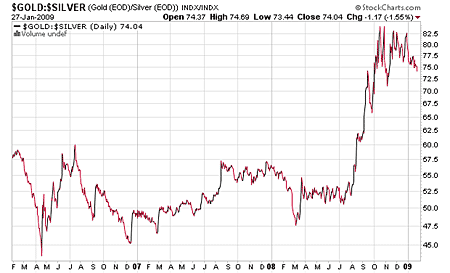
Many were calling for that ratio to fall below 20. It will one day. The historical ratio is 15 - there is 15 times as much silver in the earth's crust as gold. But we are a long way from that. We may see 100 first.
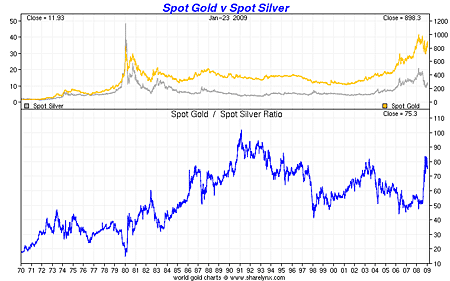
But those who bought silver with pounds will not be as disappointed as dollar buyers. It's not too far off recent highs:

The story isn't great for platinum or palladium either
I'm afraid it is the same story for platinum and palladium as with silver. Only a year or so ago, many - myself included - looked at South Africa's political problems and its energy crisis and asked where in the world platinum was going to come from. Indeed, we are still asking ourselves that.
But the market doesn't care. Though precious, platinum is still an industrial metal. The car industry is, for now, doomed, and the market has no time for platinum, despite its rarity.
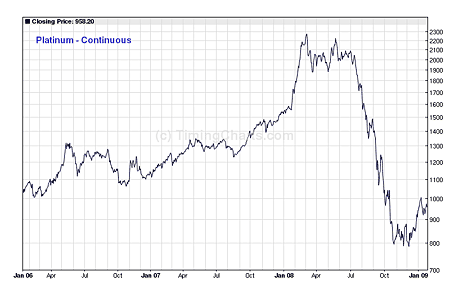
It was the same story for palladium, which fell from $600 to about $175 per ounce, and for rhodium it was even worse. The rhodium chart was amazing. It seemed to do nothing else but go up - for years this was the case - then crash.
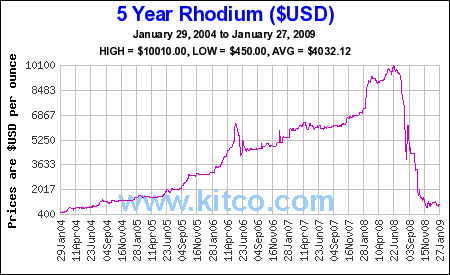
Yes, silver and platinum-group metals have a use in jewellery, but jewellery sales are down, despite its use as a store of wealth. Even gold jewellery sales are down. All the demand for gold is safe-haven investment demand.
By November, of course, the industrial precious metals had become way too cheap. The market recognised this and platinum and silver have since rallied. And I suspect they will continue to rally along with all commodities for the next month or three.
But the greater demand is for money, so over the longer term - the next three years or so - we can expect the demand for the monetary metal - gold - to be greater than the demand for the industrial.
When will gold break through $1,000 an ounce?
However, those short-term traders who play gold in dollars should perhaps exercise some caution here. It has had a good run since November and could easily bounce back off the trendline below. In fact, the ideal technical scenario is to gently pull back and then cruise through at the next attempt.
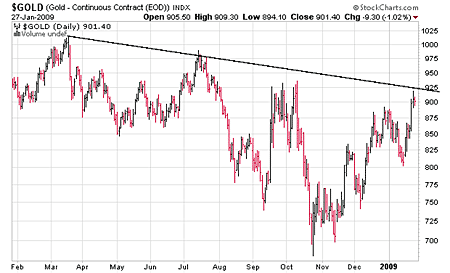
Those who read a lot of my stuff will know my theory - and it is no more than that - that gold makes six- to nine-month up-moves, followed by periods of consolidation lasting about 18 months. I suspect we are in one such period. I do not see a break-out to new highs above $1,000 in the very near future. But we'll be there by this time next year.
So, I am holding onto every ounce of gold and every quality share that I own. Gold's uber-move could strike at any time, and I don't want to miss it when it comes. Like the stock market crash of last autumn, it has been years in the making; it will be swift in the unfolding, and you have to be positioned.
If you're not in it, you will not win it.
Our recommended article for today
How to minimise your risk in the stock markets
The stock markets will be highly volatile for some time to come. But that doesn't mean you should avoid investing indeed, now is when some of the best bargains can be found. You just need to know what to look for on a company's balance sheet.
Get the latest financial news, insights and expert analysis from our award-winning MoneyWeek team, to help you understand what really matters when it comes to your finances.
MoneyWeek is written by a team of experienced and award-winning journalists, plus expert columnists. As well as daily digital news and features, MoneyWeek also publishes a weekly magazine, covering investing and personal finance. From share tips, pensions, gold to practical investment tips - we provide a round-up to help you make money and keep it.
-
 'Investors should brace for Trump’s great inflation'
'Investors should brace for Trump’s great inflation'Opinion Donald Trump's actions against Federal Reserve chair Jerome Powell will likely stoke rising prices. Investors should prepare for the worst, says Matthew Lynn
-
 The state of Iran’s economy – and why people are protesting
The state of Iran’s economy – and why people are protestingIran has long been mired in an economic crisis that is part of a wider systemic failure. Do the protests show a way out?

